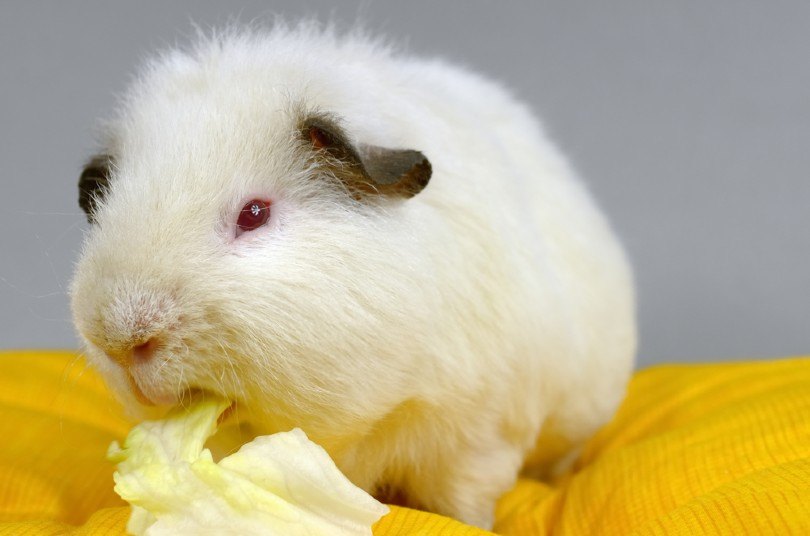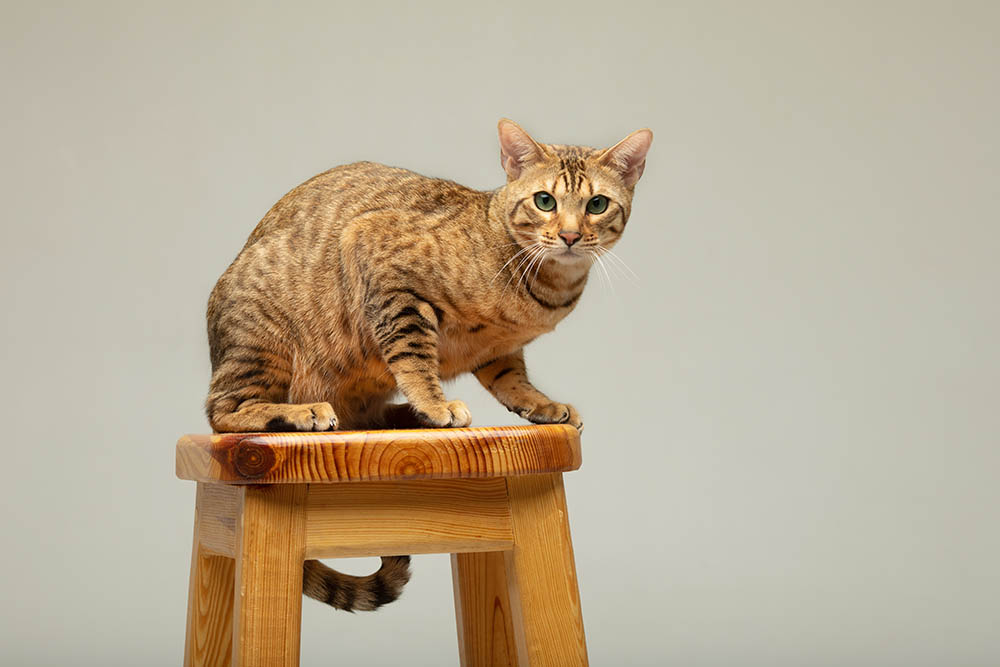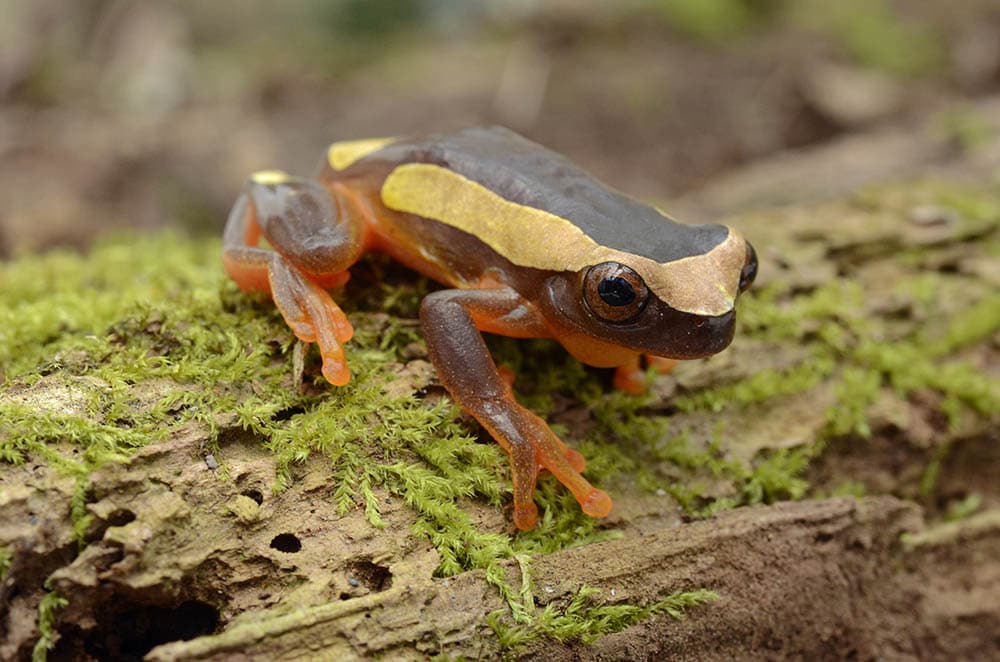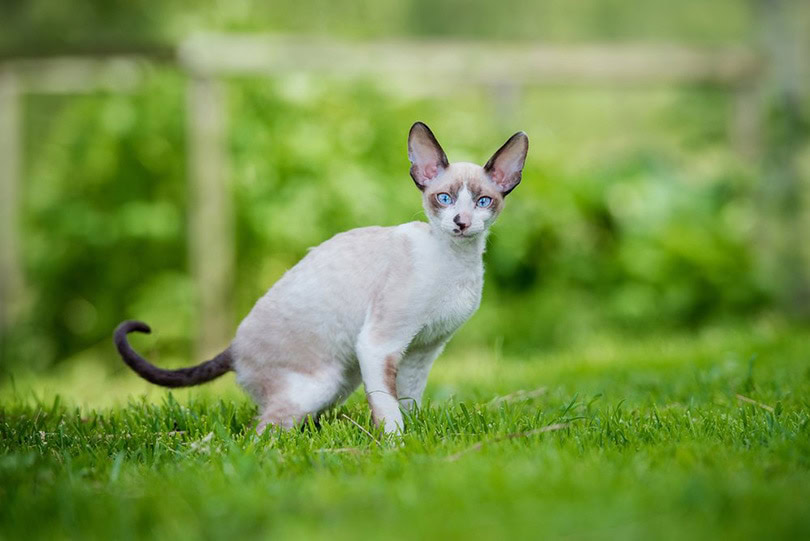Click to Skip Ahead
Guinea pigs are popular due to their adorable appearance and gentle nature. If you have considered bringing one of these animals home as a pet, you may have wondered about the Himalayan Guinea Pig. This unique breed can be an excellent fit for all sorts of family dynamics. To decide whether they’re right for you, read on!
| Size: | 8–10 inches long |
| Weight: | 1.5–2.5 lbs. |
| Lifespan: | 4–5 years |
| Similar Breeds: | Abyssinian Guinea Pig, Peruvian Guinea Pig |
| Suitable for: | First-time guinea pig owners or experienced guinea pig owners |
| Temperament: | Gentle, timid, social |
The Himalayan Guinea Pig, despite their name, does not originate in Asia. Instead, they come from South America. This guinea pig is predominantly white, but their nose, ears, or feet can range from black to brown, and their eyes are typically pink. While they are normally born pure white, they develop dark spots later in life.
There is so much more to the Himalayan than their appearance, however. Here, we discuss their temperament, intelligence, and care requirements.
Himalayan Guinea Pig Characteristics

How Much Do These Guinea Pigs Cost?
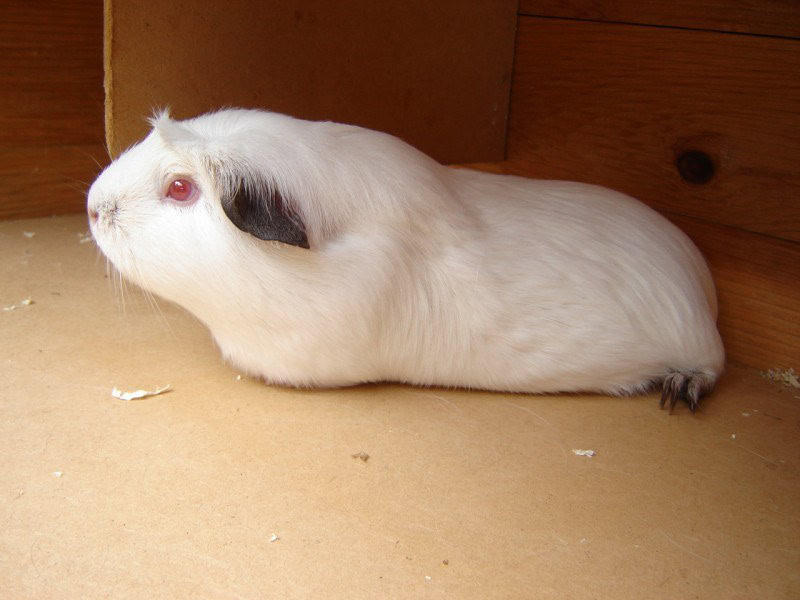
Himalayan Guinea Pigs are relatively rare. You will most likely need to find a breeder specializing in this breed and purchase your pet that way. Since they’re uncommon, the price will likely be a bit steeper. Thankfully, guinea pigs in general are quite affordable.
In addition to the purchasing cost, there are many upfront expenses that you will need to be prepared for. You will need to purchase necessary habitat supplies, grooming care items, toys, and so on.
Before bringing your Himalayan home, make sure you have a good idea of what the recurring costs will look like. Even after you’ve bought your pet and acquired the supplies for care, you will have continuous expenses like food and veterinary visits. Setting up a budget can be a great way to ensure that you are prepared to meet the costs of caring for your pet.

Temperament & Intelligence of the Himalayan Guinea Pig
The Himalayan Guinea Pig is similar to other species in terms of temperament. They are social, smart, gentle animals that thrive on interaction with humans and other guinea pigs.
They enjoy being handled when their owner knows how to do so properly. If you try to pick up your Himalayan from above, they will likely mistake your hand for a swooping bird of prey and panic. Therefore, you should always approach your pet from their side.
Since they are prey animals, guinea pigs can be timid and fearful. To help your cavy feel safe in your presence, you should always be patient and gentle with your touch. While Himalayan Guinea Pigs are not typically aggressive animals, they can bite if they are startled or threatened.
Do These Guinea Pigs Make Good Pets?
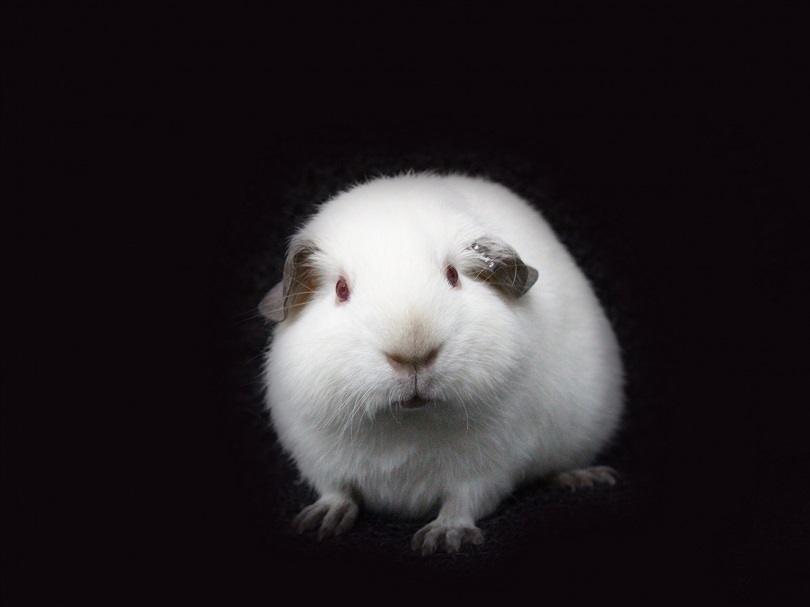
Many owners commend their Himalayan Guinea Pigs for being sweet, loving, and calm creatures. As a result, they are favorites among experienced owners. This affectionate creature loves humans and makes an excellent pet. They are social and enjoy spending time with their favorite person.
While the Himalayan’s gentleness can make them a great pet for children, it is advised that you take caution when bringing a guinea pig into a home with young children. Those who have not yet learned boundaries around animals may overwhelm and frighten them, causing them to nip whenever a child grabs them.
Similarly, if young kids don’t understand their own strength compared to that of a guinea pig, they may accidentally harm the poor animal. Therefore, the Himalayan is better for families with older children.
Does the Himalayan Guinea Pig Get Along With Other Pets?
Since the Himalayan Guinea Pig is so social, they typically get along with other pets well. Lone Himalayans are not as happy as those with a buddy. They love interacting with others and having roommates fulfills their social needs.
However, Himalayan Guinea Pigs are unsuitable for households with dogs, cats, or other large animals. They will likely view the guinea pig as prey and may chase or even injure your pet. Even if your cavy manages to escape the chase, the fright might be so great that they are permanently affected.

Things to Know When Owning a Himalayan Guinea Pig
Before bringing your Himalayan Guinea Pig home, it’s best to learn more about their care requirements, including their diet, enclosure needs, exercise and training obligations, and grooming care. You should also know of any health conditions that your pet may be prone to and possible differences between the sexes.
Food & Diet Requirements
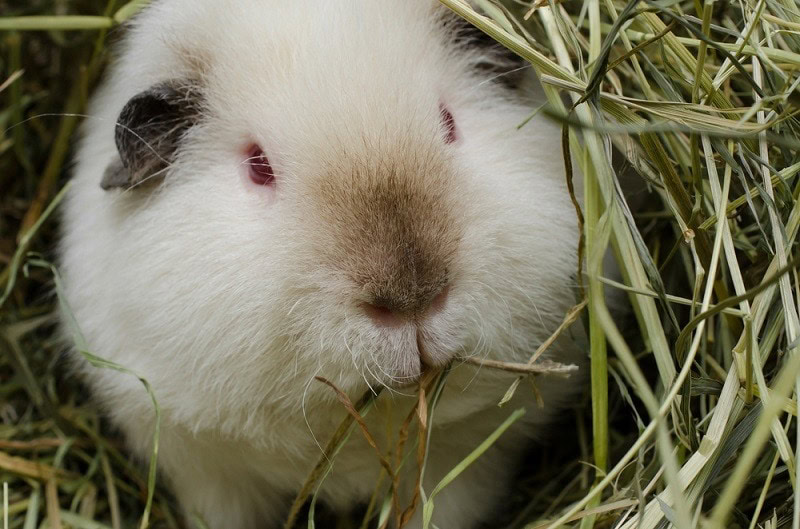
The Himalayan Guinea Pig is herbivorous, as are all guinea pigs. They will only eat plants and plant-based materials. You should never try to feed your cavy any meat or animal protein since their body is not built to process it.
Instead, focus on providing a consistent source of grass hay. This is an essential part of your guinea pig’s diet and should make up the bulk of their meals. Excellent grass hays that you can feed your pet include Timothy hay or orchard hay. You can also provide pellets and fresh veggies to balance out their diet. Fresh fruits should be considered treats and only be offered on occasion.
Vitamin C is vital to your Himalayan Guinea Pig’s diet. They cannot produce their own vitamin C, so make sure you are offering it to them in their food. Similarly, clean and fresh water should always be available for your pet.
Habitat & Enclosure Requirements
Guinea pigs may be small animals, but they cannot thrive in small cages. You’ll need a significant amount of ground space in your pet’s enclosure. The sides of the cage should be at least 12” high. The top of the enclosure can be open as long as no small children or other pets can access it.
Providing enrichment in your Himalayan Guinea Pig’s enclosure is vital. With ramps, platforms, and plenty of room to run around, your pet should have enough to entertain themselves when they can’t play outside the cage.
One of the best materials to make an enclosure out of is coroplast, a corrugated plastic. Glass aquariums, plastic tubs, and cages with wire floors are unsuitable for these animals. The number of guinea pigs that you want to house in one enclosure will determine how large it needs to be.
For one guinea pig, the minimum is 30” by 36”. Of course, bigger is better, but if you meet this minimum, you are providing adequate care for your pet. For two guinea pigs, you will need an enclosure that is 30” by 50”; for three, you will need one that’s 30” by 62”; for four , you will need one that’s 30” by 76”.
Exercise & Sleeping Needs
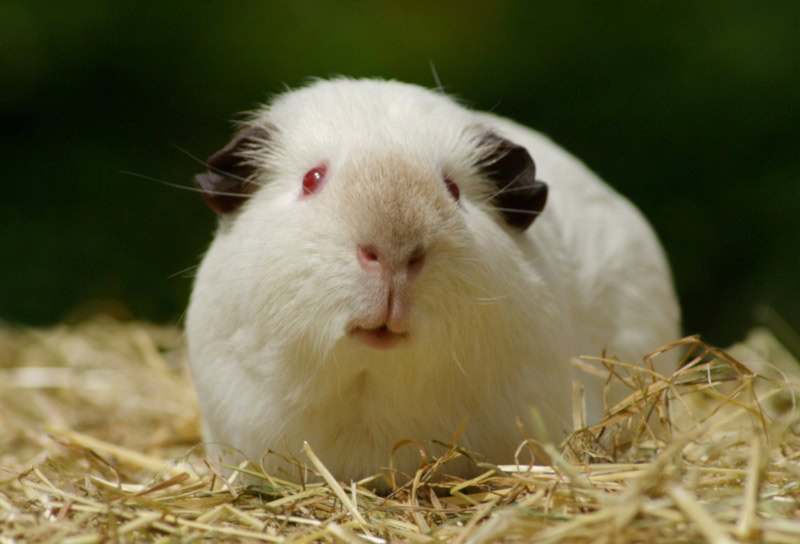
Exercise is important to a healthy, happy Himalayan Guinea Pig’s routine. Spending time outside of their cage is beneficial to their physical and mental health. Make sure your pet gets a good amount of time outside the enclosure each day to run around and burn energy.
Training
Since the Himalayan Guinea Pig is so receptive to human contact, they are relatively easy to train. You can teach your pet fun tricks like jumping, spinning, or giving a high five. Additionally, you can teach them complex problem-solving; they have been known to navigate complex mazes.
Grooming
Most Himalayan Guinea Pigs have short hair, so their grooming care is relatively limited. You will need to clean your pet’s feet and hind end and bathe them when necessary. Occasionally, you may need to trim their hair and nails.
When bathing your pet, be careful that the water is not too cold or hot. Lukewarm water is the safest temperature. Use a gentle pet shampoo and dry them with a towel. Do not use a hair dryer to dry them off since it can easily overheat your Himalayan.
Lifespan and Health Conditions 🏥
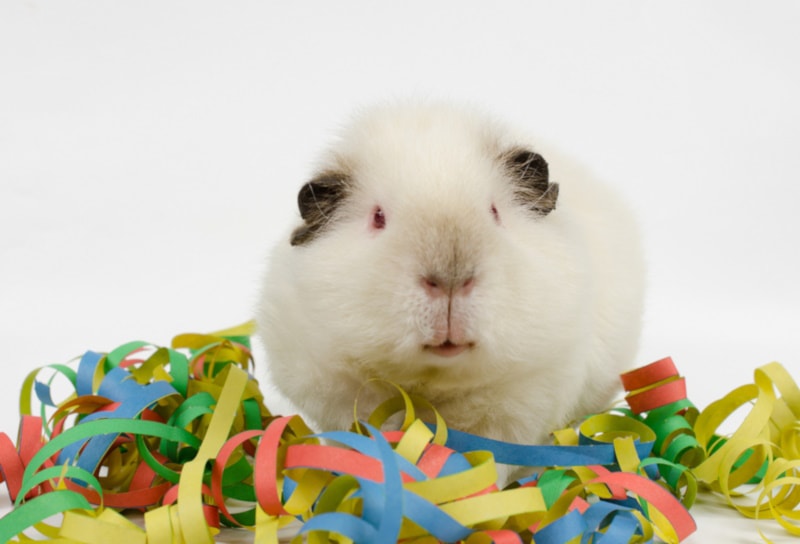
Some health conditions that a Himalayan Guinea Pig can experience are serious, while others are minor. However, all of them deserve attention and prompt care. One of the most severe conditions that your pet may face is hypovitaminosis C, or a vitamin C deficiency.
Your Himalayan cannot produce vitamin C, so if they do not receive an adequate amount in their diet, they may develop a deficiency. Without treatment, it can lead to sepsis, progressive paralysis, and even death.
Other conditions to watch out for are dental issues and urinary stones. There are various types of dental diseases that your guinea pig may suffer from, so watch for signs of discomfort or dysfunction around the mouth. Urinary stones are another issue that they commonly face, which may affect your pet’s kidneys, ureters, bladder, and urethra.
- Dental issues
- Urinary stones
- Hypovitaminosis C
Male vs. Female
Since the Himalayan Guinea Pig does not like to live alone, housing them with another Himalayan is ideal. However, be cautious of housing a male and female together. Guinea pigs can reproduce rapidly, so if you are not careful, you may end up with more pets than you could’ve ever imagined.
The only way to discern the difference between a male and female Himalayan Guinea Pig accurately is to check their genitals. There are no outstanding physical differences otherwise, and they share the same gentle temperament.


3 Little-Known Facts About the Himalayan Guinea Pig
1. Unique Origins
The Himalayan Guinea Pig originated in South America.
2. Cat-Like Appearance
This breed closely resembles the Siamese cat.
3. Long Lifespan
Himalayan Guinea Pigs can live 8 years or longer in the right conditions.

Final Thoughts
Himalayan Guinea Pigs are shy yet friendly animals with a lot of love to give to their favorite humans. Whether you are a first-time owner or an experienced pet parent, the Himalayan can make an excellent addition to your home. Due to their amiable temperament, they are ideal for families, as long as younger children are taught how to handle them gently.
We hope that this article has informed you about the fundamentals of caring for a Himalayan Guinea Pig. These incredible creatures deserve only the best of care, so if you bring one home, collaborate closely with your vet to ensure that you are providing the best lifestyle for your furry friend.
See also:
- https://www.chesapeakeveterinary.com/2022/10/02/guinea-pig-breeds/
- https://thepetfaq.com/himalayan-guinea-pig/
- https://www.thesprucepets.com/himalayan-guinea-pig-5223355
- https://www.animallama.com/guinea-pigs/himalayan-guinea-pigs/
- https://www.humanesociety.org/resources/guinea-pig-housing#
- https://www.rspca.org.uk/adviceandwelfare/guineapigs/sexing
- https://www.petmd.com/exotic/conditions/cardiovascular/c_ex_gp_vitamin_c_deficiency
- https://www.petmd.com/exotic/conditions/mouth/c_ex_gp_dental_diseases
Featured Image Credit: PHOTO FUN, Shutterstock
